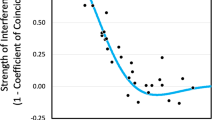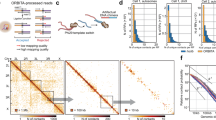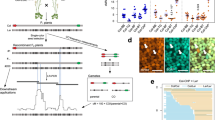Abstract
The insertion site localization of the 412 retrotransposable element was analysed by in situ hybridization to the polytene chromosomes of 57 individual genomes from 25 natural populations of Drosophila simulans. The 412 insertion sites along the chromosomes show a tendency to aggregate in the distal and proximal ends of the 2R arm, and in several local regions along the 3R arm. The distribution of the 412 insertion sites, weighted by DNA content, along the chromosome arms reveals an overall tendency for the site number to increase from the middle of the arm to the base and tip, with a decrease at the tips, especially pronounced for the X chromosome. Such a distribution differs slightly from that of D. melanogaster, which globally shows an increase of the 412 site number from base to tip of the chromosome arms, indicating differing behaviour of the 412 element in the two species. These results are discussed in connection with the recombination rate along the chromosome arms.
Similar content being viewed by others
Article PDF
References
Ashburner, M. 1989. Drosophila A Laboratory Handbook. Cold Spring Harbor Laboratory Press, New York.
Aulard, S, Lemeunier, F, Hoogland, C, Chaminade, N, Brookfield, J F, and Biémont, C. 1995. Chromosomal distribution and population dynamics of the 412 retro-transposon in a natural population of Drosophila melanogaster. Chromosoma, 103, 693–699.
Biémont, C. 1992. Population genetics of transposable DNA elements. A Drosophila point of view. Genetica, 86, 67–84.
Biémont, C. 1994. Dynamic equilibrium between insertion and excision of P elements in highly inbred lines from an M' strain of Drosophila melanogaster. J Mol Evol, 39, 466–472.
Biémont, C, Lemeunier, F, Garcia Guerreiro, M P, Brookfield, J F, Gautier, C, Aulard, S, and Pasyu-Kova, E G. 1994. Population dynamics of the copia, mdgl, mdg3, gypsy, and P transposable elements in a natural population of Drosophila melanogaster. Genet Res, 63, 197–212.
Bolshakov, V N, Zharkikh, A A, and Zhimulev, I F. 1985. Intercalary heterochromatin in Drosophila. II. Heterochromatic features in relation to local DNA content along the polytene chromosomes of Drosophila melanogaster. Chromosoma, 92, 200–208.
Caggese, C, Pimpinelli, S, Barsanti, P, and Caizzi, R. 1995. The distribution of the transposable element Bari-1 in the Drosophila melanogaster and Drosophla simulans genomes. Genetica 96, 269–283.
Charlesworth, B, and Charleswoth, D. 1983. The population dynamics of transposable elements. Genet Res, 42, 1–27.
Charlesworth, B, and Langley, C H. 1989. The population genetics of Drosophila transposable elements. Ann Rev Genet, 23, 251–287.
Charlesworth, B, and Lapid, A. 1989. A Study of 10 transposable elements on X chromosomes from a population of Drosophila melanogaster. Genet Res, 54, 113–125.
Charlesworth, B, Lapid, A, and Canada, D. 1992a. The distribution of transposable elements within and between chromosomes in a population of Drosophila melanogaster. I. Element frequencies and distribution. Genet Res, 60, 103–114.
Charlesworth, B, Lapid, A, and Canada, D. 1992b. The distribution of transposable elements within and between chromosomes in a population of Drosophila melanogster. II. Inferences on the nature of selection against elements. Genet Res, 60, 115–130.
Charlesworth, B, Jarne, P, and Assimacopoulos, S. 1994a. The distribution of transposable elements within and between chromosomes in a population of Drosophila melanogaster. III. Element abundances in heterochromatin. Genet Res, 64, 183–197.
Charlesworth, B, Sniegowski, P, and Stephan, W. 1994b. The evolutionary dynamics of repetitive DNA in eukaryotes. Nature, 371, 215–220.
Csink, A K, and McDonald, J F. 1990. Copia expression is variable among natural populations of Drosophila. Genetics, 126, 375–385.
Dowsett, A P, and Young, M W. 1982. Differing levels of dispersed repetitive DNA among closely related species of Drosophila. Proc Natl Acad Sci USA, 79, 4570–4574.
Finnegan, D J, Rubin, G M, Young, M W, and Hogness, D C. 1978. Repeated gene families in Drosophila melanogaster. Cold Spring Harbor Symp Quant Biol, 42, 1053–1064.
Hoogland, C, and Biémont, C. 1996. Chromosomal distribution of transposable elements in Drosophila melanogaster: test of the ectopic recombination model for maintenance of insertion site number. Genetics, 144, 197–204.
Kaplan, N L, and Brookfield, J F Y. 1983. Transposable elements in Mendelian populations. III. Statistical results. Genetics, 104, 485–495.
Kaplan, N L, Darden, T, and Langley, C H. 1985. Evolution and extinction of transposable elements in Mendelian populations. Genetics, 109, 459–480.
Kimura, K, and Kidwell, M G. 1994. Differences in P element population dynamics between the sibling species Drosophila melanogaster and Drosophila simulans. Genet Res, 63, 27–38.
Langley, C H, Brookfield, J F Y, and Kaplan, N. 1983. Transposable elements in Mendelian populations. I. A theory. Genetics, 104, 457–472.
Langley, C H, Montgomery, E A, Hudson, R, Kaplan, N, and Charlesworth, B. 1988. On the role of unequal exchange in the containment of transposable element copy number. Genet Res, 52, 223–235.
Lefevre, G. 1976. A photographic representation and interpretation of polytene chromosomes of Drosophila melanogaster salivary glands. In: Ashburner, M. and Novitski, E. (eds) The Genetics and Biology of Drosophila, 1A, pp. 31–66. Academic Press, London.
Lehmann, E L. 1975. Nonparametrics Statistical Methods Based on Ranks. McGraw Hill, New York.
Leibovitch, B, Aglushkova, I V, Pasyukova, E G, Belyaeva, E S, and Gvozdev, V A. 1992. Comparative analysis of retrotransposon localization and mobility in sibling species Drosophila simulans and Drosophila melanogaster. Genetika, 28, 85–97.
Lindsley, D L, and Sandler, L. 1977. The genetic analysis of meiosis in female Drosophila melanogaster. Phil Trans R Soc B, 277, 295–312.
Miklos, G L G, Yamamoto, M T, Davies, J, and Pirrotta, V. 1988. Microcloning reveals a high frequency of repetitive sequences characteristic of chromosome 4 and the β-heterochromatin of Drosophila melanogaster. Proc Natl Acad Sci USA, 85, 2051–2055.
Montgomery, E A, Charlesworth, B, and Langley, C H. 1987. A test for the role of natural selection in the stabilization of transposable element copy number in a population of Drosophila melanogaster. Genet Res, 49, 31–41.
Nuzhdin, S V. 1995. The distribution of transposable elements on X chromosomes from a natural population of Drosophila simulans. Genet Res, 66, 159–166.
Sniegowski, P, and Charlesworth, B. 1984. Transposable element numbers in cosmopolitan inversions from a natural population of Drosophila melanogaster. Genetics, 137, 815–827.
Sorsa, V. 1988. Chromosome maps of Drosophila, II. CRC Press Inc., Boca Raton. FL.
Stephan, W, and Langley, C H. 1992. Evolutionary consequences of DNA mismatch inhibited repair opportunity. Genetics, 132, 567–574.
True, J R, Mercer, J M, and Laurie, C C. 1996. Differences in crossover frequency and distribution among three sibling species of Drosophila. Genetics, 142, 507–523.
Vaury, C, Bucheton, A, and Pelisson, A. 1989. The β-heterochromatic sequences flanking the I elements are themselves defective transposable elements. Chromosoma 98, 215–224.
Vieira, C, and Biémont, C. 1996a. Geographical variation in insertion site number of retrotransposon 412 in Drosophila simulans. J Mol Evol, 42, 443–451.
Vieira, C, and Biémont, C. 1996b. Selection against transposable element insertions in D. simulans and D. melanogaster. Genet Res, 68, 9–15.
Author information
Authors and Affiliations
Corresponding author
Rights and permissions
About this article
Cite this article
Hoogland, C., Vieira, C. & Biémont, C. Chromosomal distribution of the 412 retrotransposon in natural populations of Drosophila simulans. Heredity 79, 128–134 (1997). https://doi.org/10.1038/hdy.1997.135
Received:
Issue date:
DOI: https://doi.org/10.1038/hdy.1997.135



